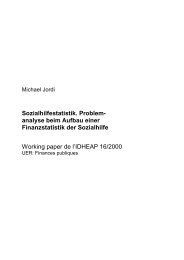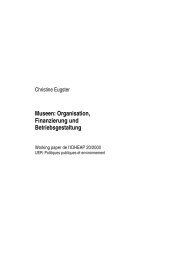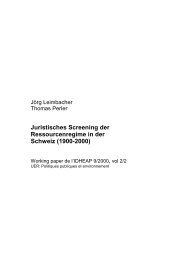Local Government and Metropolitan Regions in Switzerland - IDHEAP
Local Government and Metropolitan Regions in Switzerland - IDHEAP
Local Government and Metropolitan Regions in Switzerland - IDHEAP
You also want an ePaper? Increase the reach of your titles
YUMPU automatically turns print PDFs into web optimized ePapers that Google loves.
Section 8: Political culture of local governance<br />
Although local politics is often considered to be more pragmatic, more oriented towards problem-solv<strong>in</strong>g<br />
<strong>and</strong> less about ideologies, there is a large number of political parties to be found at local level, especially<br />
when we consider the small size of most municipalities. More than 60 percent of the municipalities<br />
have political parties which are subsections of the national parties. The percentage of municipalities with<br />
political parties was even higher twenty years ago. S<strong>in</strong>ce then, political parties have been los<strong>in</strong>g their<br />
<strong>in</strong>fluence at least <strong>in</strong> the smaller municipalities (Ladner 1999). In these municipalities there has also been<br />
an <strong>in</strong>crease of no-party members elected <strong>in</strong>to the local executive. Today, about 30 percent of the members<br />
of the local executives do not have a party affiliation.<br />
The pr<strong>in</strong>ciple of power shar<strong>in</strong>g (see L<strong>in</strong>der 1994, Lijphart 1999) not only applies to the federal government,<br />
<strong>in</strong> which the four biggest parties are represented, but also to the cantonal <strong>and</strong> local executives.<br />
There are hardly any s<strong>in</strong>gle-party executives <strong>and</strong> the most important parties are usually represented <strong>in</strong><br />
the local executive. This might at first sight be surpris<strong>in</strong>g, s<strong>in</strong>ce the majority system for the election of<br />
the executive is the rule <strong>in</strong> most cantons <strong>and</strong> municipalities. In accordance with the pr<strong>in</strong>ciples of consociational<br />
democracy (“Konkordanzdemokratie”), however, a “voluntary proportionality” (“freiwilliger Proporz”)<br />
is practised. The lead<strong>in</strong>g party absta<strong>in</strong>s from present<strong>in</strong>g a full slate of c<strong>and</strong>idates to make room<br />
for opposition party c<strong>and</strong>idates. In smaller communities, of course, absta<strong>in</strong><strong>in</strong>g from runn<strong>in</strong>g for all seats<br />
is not always voluntary, as it can be difficult to f<strong>in</strong>d suitable c<strong>and</strong>idates for each available seat. Runn<strong>in</strong>g<br />
for all seats also carries the danger that some of the same party c<strong>and</strong>idates take votes away from each<br />
other <strong>and</strong> fall beh<strong>in</strong>d the c<strong>and</strong>idates of the other parties. And sometimes the parties present fewer c<strong>and</strong>idates<br />
to avoid the risk of possible defeat, especially when runn<strong>in</strong>g aga<strong>in</strong>st current office-holders. One<br />
common strategy for the lead<strong>in</strong>g party is to absta<strong>in</strong> from runn<strong>in</strong>g for all seats under certa<strong>in</strong> conditions.<br />
The smaller parties are offered a number of seats <strong>in</strong> accordance with their strength. In return they have<br />
to br<strong>in</strong>g forward c<strong>and</strong>idates which suit the stronger parties.<br />
The Swiss militia system <strong>and</strong> the smallness of the political units lead to a high degree of citizens’ <strong>in</strong>volvement<br />
<strong>in</strong> hold<strong>in</strong>g public office. Tak<strong>in</strong>g the seats <strong>in</strong> the local executives <strong>and</strong> parliament together with<br />
the various commissions <strong>in</strong> the different policy fields, an average of about 50 different political functions<br />
per municipality have to be filled by the citizens. In small municipalities, one out of eight or ten citizens<br />
holds a public office. This can be seen as a form of social capital. In recent years, however, this high<br />
dem<strong>and</strong> to fill offices has <strong>in</strong>creas<strong>in</strong>gly encountered problems on the supply side. The municipalities <strong>and</strong><br />
more particularly the local political parties, which are the most important recruitment agents for public<br />
office holders, f<strong>in</strong>d it <strong>in</strong>creas<strong>in</strong>gly difficult to recruit enough qualified c<strong>and</strong>idates. The fact that a municipality<br />
has a parliament can, on one h<strong>and</strong>, make it easier for the parties to recruit c<strong>and</strong>idates among the<br />
members of the parliament to run the elections for the local executive. On the other h<strong>and</strong>, they have to<br />
f<strong>in</strong>d enough c<strong>and</strong>idates for their seats <strong>in</strong> the parliament <strong>in</strong> the first place. Accord<strong>in</strong>g to our survey results,<br />
it is most difficult to f<strong>in</strong>d enough c<strong>and</strong>idates <strong>in</strong> the medium-sized municipalities. In the cities, public<br />
offices are sufficiently prestigious <strong>and</strong>, <strong>in</strong> the case of a seat <strong>in</strong> the executive, well remunerated. In the<br />
very small municipalities these offices are less time-consum<strong>in</strong>g <strong>and</strong> it is probably more difficult to refuse<br />
an <strong>in</strong>vitation if it becomes obvious that there is nobody else to do the job.<br />
<strong>Local</strong> elections are by no means second order elections. Voter’s turnout at local elections happens to be<br />
even higher compared to turnout at cantonal <strong>and</strong> national level, at least <strong>in</strong> smaller municipalities up to<br />
5000 <strong>in</strong>habitants (see figure 1). The decl<strong>in</strong>e of turnout <strong>in</strong> local affairs <strong>in</strong> bigger municipalities becomes<br />
particularly salient when we look at the percentage of people attend<strong>in</strong>g a local assembly (see figure 2).<br />
In the smallest municipalities about one quarter of the citizens appear <strong>in</strong> these meet<strong>in</strong>gs whereas <strong>in</strong> the<br />
biggest municipalities it is only a few percent.<br />
17










